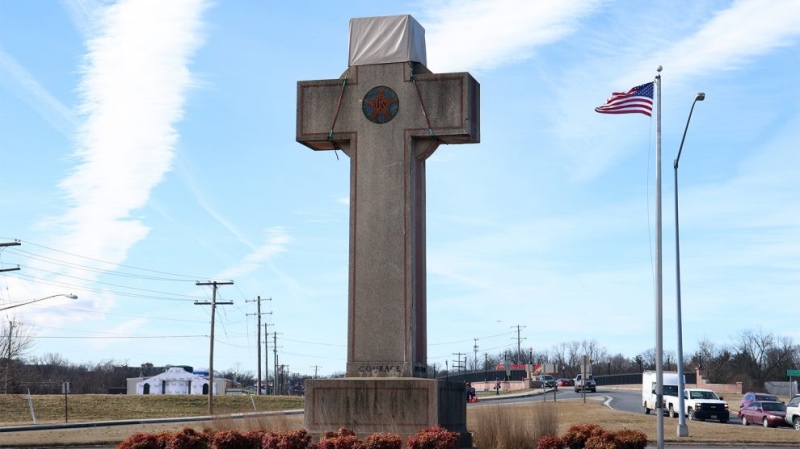
In an article first published on Religion News Service, AMANDA TYLER, executive director of the Baptist Joint Committee for Religious Liberty, comments on last week’s decision concerning a war memorial known as the Bladensburg Cross…
Via RNS
In last week’s decision in The American Legion vs American Humanist Association, the US Supreme Court held that a free-standing, 12 metre high cross on government land in Bladensburg, Maryland, did not violate the First Amendment’s “no establishment” clause, reversing the lower court’s ruling below.
Seven justices agreed with that judgment, with only Justices Ruth Bader Ginsburg and Sonia Sotomayor dissenting. But the ruling was splintered and the decision more limited than the vote count suggests.

The 12 metre high Bladensburg Peace Cross stands on a government-owned intersection in Bladensburg, Maryland, north-east of Washington, DC. PICTURE: Adelle M Banks/RNS
“For many court watchers, including BJC, it is difficult to reconcile the promise of religious liberty for all with the constitutionality of a massive Latin cross sponsored by the government. One takeaway from this case could be that an unconstitutional establishment can become permissible if it stays up long enough without objection.”
In upholding the argument that the monument should remain, the majority opinion written by Justice Samuel Alito focused on its specific history and its context as a World War I memorial. The opinion emphasised that this cross was originally dedicated to 49 individuals from the local community who were killed in the war.
According to the majority, the “plain Latin cross…took on a new meaning after World War I,” as a “‘central symbol’ of the conflict”. In several places throughout his opinion, Alito emphasised the monument’s old age, having been erected in 1925, and how those 94 years changed both its purpose and the message it conveyed.
Perhaps most important to the outcome of this case, the court worried about the divisive impact to remove or alter the monument, “especially to the local community for which it has taken on particular meaning”.
In their decision, however, the court opted against some of the extreme arguments put forth by the government and its allies that would have had more far-reaching consequences. The court rejected an approach that would ignore concern for government neutrality between different faiths and require government coercion. Sticking to the facts of this particular memorial and divisive consequences of its potential removal, Alito wrote that the facts at hand were “quite different from erecting or adopting new” monuments.
The court also avoided sweeping arguments that the cross lacked religious content and had become a universal symbol of sacrifice. Thankfully, the court rejected this offensive argument by acknowledging the obvious – that the cross is a Christian symbol, albeit one in its view that had taken on additional meaning in this specific instance.
The dissent emphasised the religious nature of the cross. Quoting from BJC’s friend-of-the-court brief in the first of several passages, Justice Ginsburg described the exclusive meaning of the cross: “The Latin cross is the foremost symbol of the Christian faith, embodying the ‘central theological claim of Christianity: that the son of God died on the cross, that he rose from the dead, and that his death and resurrection offer the possibility of eternal life.’”
Ginsburg wrote how the majority’s ruling eroded the First Amendment’s promise of neutrality among faiths and between religion and non-religion and sent as well a “message of exclusion” to the estimated 30 per cent of Americans who are not Christian.
Though they disagreed with Ginsburg’s conclusion on the effect of the Bladensburg Cross, the justices in the majority continued to emphasise neutrality principles in their opinions. Alito said the First Amendment’s religion clauses “aim to foster a society in which people of all beliefs can live together harmoniously”.
Justice Brett Kavanaugh repeated a statement he had made during his confirmation hearings: “All citizens are equally American, no matter what religion they are, or if they have no religion at all.”
Justice Elena Kagan voiced support for “this Nation’s pluralism, and the values of neutrality and inclusion that First Amendment demands.” Justice Stephen Breyer reinforced “the basic purposes that the Religion Clauses were meant to serve: assuring religious liberty and tolerance for all, avoiding religiously based social conflict, and maintaining that separation of church and state that allows each to flourish in its ‘separate sphere’.”
For many court watchers, including BJC, it is difficult to reconcile the promise of religious liberty for all with the constitutionality of a massive Latin cross sponsored by the government. One takeaway from this case could be that an unconstitutional establishment can become permissible if it stays up long enough without objection.
It will take citizens committed to the principle that there are no second-class faiths in this country to remain vigilant to make sure that the Bladensburg Cross remains a relic of the past and not an example for the future.
Amanda Tyler is executive director of the BJC (Baptist Joint Committee for Religious Liberty), an 83-year-old religiously based organisation working to defend religious freedom for all people and protect the institutional separation of church and state in the historic Baptist tradition.





